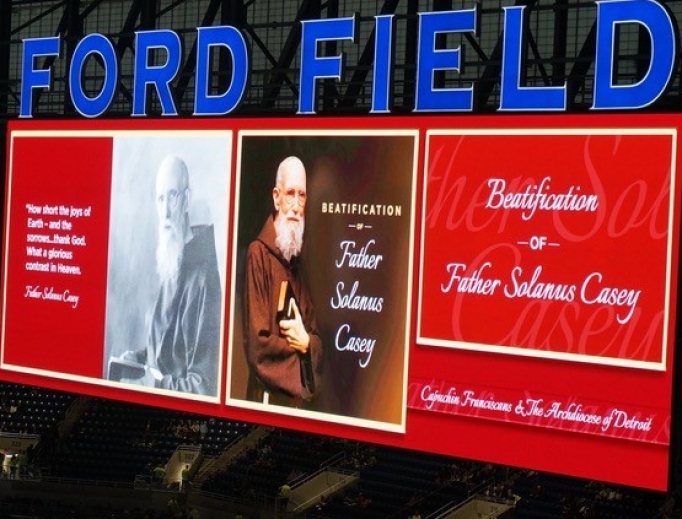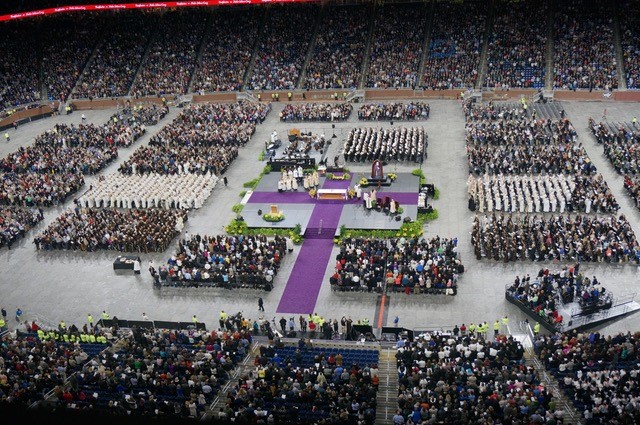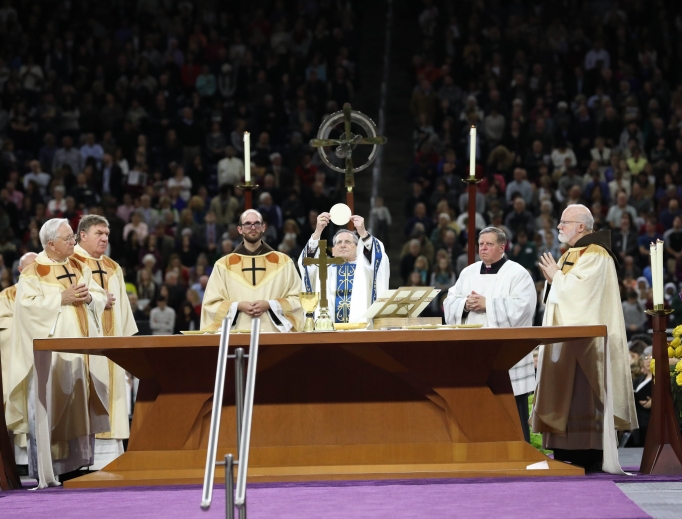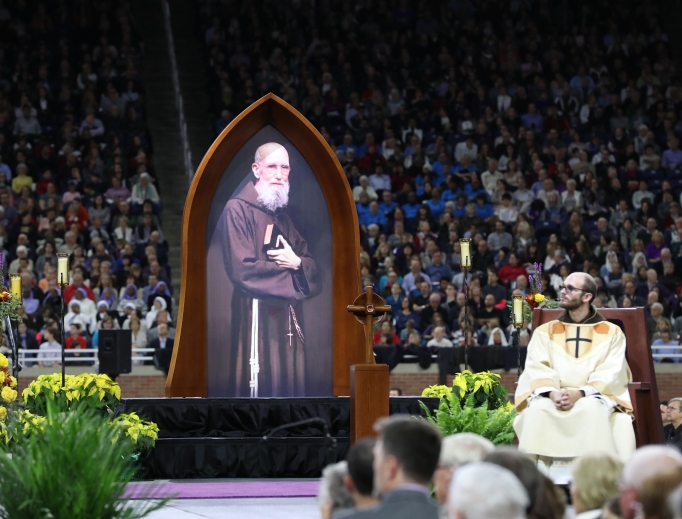Blessed Solanus: The Beatification of the Porter of St. Bonaventure
Father Casey is raised to the altars in Detroit, where he is much loved among the faithful and relatives alike.

DETROIT — Father Solanus Casey’s beatification Nov. 18 at Ford Field in Detroit testified to the fact that God does indeed lift up the lowly.
A portrait of the thin, scraggly-bearded Capuchin appeared on the JumboTron at the football arena, which had been transformed into a sacred space.
More than 66,000 pilgrims had come to honor a man with no skills to speak of, but who had emptied himself so completely that God was able to fill him with supernatural gifts.

This was only the third beatification held in the United States. Blessed Solanus is the second U.S. male to be beatified; the first was Blessed Stanley Rother in Oklahoma City in September. The other beatification held in the U.S. was that of Blessed Miriam Demjanovich.
When Blessed Solanus was ordained in 1904 with the Capuchins of Detroit as a “simplex priest,” without faculties to hear confession or preach a homily, he seemed to be the lowliest of priests.
As the doorkeeper at St. Bonaventure Monastery in Detroit from 1924 to 1945, he was beloved for his comfort and prayers for visitors. He became well known for the many miracles that followed.
Sixty years after he died at the age of 86, on July 31, 1957, the city of Detroit witnessed a grand confirmation of his holiness.
Cardinal Angelo Amato from Rome, prefect of the Vatican’s Congregation for the Causes of Saints and representative of Pope Francis, presided over the Mass. Concelebrating were four cardinals, 28 bishops and at least 285 priests.

On the altar platform with the clergy was Paula Medina Zarate, a retired schoolteacher from Panama whose miraculous cure from a skin disease occurred after she prayed at Blessed Solanus’ tomb at the Solanus Casey Center in September 2012.
At the beginning of Mass, Cardinal Amato read the letter written in Latin from Pope Francis officially declaring Father Solanus to be “Blessed.”
Detroit Archbishop Allen Vigneron read an English version: “The Church decrees that the venerable servant of God, Francis Solanus, known in the world as Bernard Casey … a humble and faithful disciple of Christ, tireless in serving the poor … henceforth be called by the name of ‘Blessed.’”

Capuchin Brother Richard Merling, a friar who worked for decades as the co-vice postulator of the cause, told the crowd about a life that exemplified holiness.
“During his final illness, he remarked: ‘I'm offering my suffering that all might be one," Brother Richard said. "If only I could see the conversion of the whole world.’ His last conscious act was to sit up in bed and exclaim, ‘I give my soul to Jesus Christ.’”
“Today, the Church and society still need the example and the protection of Father Solanus,” Cardinal Amato said in his homily. “He did not see the poor as an obstacle, but as a way to light his path to the splendor of God.”
He noted that “prayer was his constant practice of charity,” and “he had a sense of devotion to Mary and recited the Rosary with devotion.”
“His profound faith allowed him to receive others as a brother, independent of their faith or allegiance,” the cardinal said. “He used to say that confidence in God produces serenity and joy and takes away trouble and sorrow.”
Even before Vatican II, Father Solanus was ecumenical, praying with people from any creed, Cardinal Amato said. “He saw people as human beings and did not pay attention to color, religion or creed. He spent hours and hours listening to people. The greatest part of his time as a porter was dedicated to others.”
The cardinal explained that the holy priest’s favorite sons were the poor, the sick, the indigent and the homeless.
“He always fasted in order to give them their own lunch.” Cardinal Amato shared a story of a time when the soup kitchen that Father Solanus helped open during the Depression ran out of food. “More than 200 people were still waiting to eat. He began reciting the Our Father. A baker appeared at the door and had bread and other things. When the people saw this, they began to cry with emotion. Father Solanus simply stated: ‘See? God provides. No one will suffer if we put our trust in divine Providence.’”
The crowd laughed when Cardinal Amato pointed out Blessed Solanus’ one “flaw”: his poor musical abilities. On Sunday evenings when the priest played Irish religious songs in front of the tabernacle, the Lord listened patiently, he said, “because our Blessed was lacking in music, but not in virtue.”
The homily ended with the cardinal asking people to repeat after him, “Blessed Father Solanus Casey, pray for us.”
Casey Descendants
Among the faithful at the Mass were 350 descendants of the Casey family. Father Solanus was the sixth child in a family of 10 boys and six girls born to Irish immigrant parents who left Ireland after the famine years.
Maria Joyce traveled from Idaho with 20 other family members related to her great-grandmother Margaret, a younger sister of Blessed Solanus. “Mom always had Father Solanus’ portrait on the wall,” she said. “In 1995, when he was given the title ‘Venerable,’ Mom could hardly wait to call and let all of us know!”
Jim Murphy and his brother Robert came from New Jersey. They are third cousins of Father Solanus. “My father told me when I was 18, in 1955, that, one day, Father Solanus would be a saint,” he said.
Jerry Sheils and three of his siblings came all the way from southern Ireland. They were related through Father Solanus’ grandmother who had emigrated. “Many people in Ireland know about him,” he said. “It’s awesome to be a part of this occasion. I feel overwhelmed by it.”
Beloved in Detroit
Blessed Solanus Casey is a household name among many Catholics in the Detroit Archdiocese. Tom Rashid grew up in Dearborn, Michigan, hearing about Father Solanus through his mother, who was a member of the Father Solanus Guild.
“My mother was Irish, and she had eczema like he did, so she felt a special kinship with him,” Rashid explained. He always carries with him a Father Solanus relic badge with a piece of cloth that has been touched to the holy friar’s tomb. “That is why I will only wear shirts with a pocket.”
Bill McGowen, a 67-year-old employee of Ford Field in safety management, requested to work the blessed event.
“When I was a young boy, I met Father Solanus outside St. Bonaventure one Easter,” he said. “I remember him smiling. I asked my dad, ‘Is that the same priest who prayed for Jimmy’s grandma and she got better?’”
McGowen credits Father Solanus with intervening to help him through several recent major surgeries, too. “Father Solanus is also helping to heal this city spiritually,” he said. “You can feel it.”
Cardinal Joseph Tobin flew in from Newark, New Jersey, explaining he did not want to miss the holy event.
“It’s a great day for Detroit,” he said. “I’m originally from Holy Redeemer parish in Detroit, and I was stationed there for 11 years. I heard about Father Solanus growing up. He healed a neighbor of ours who was losing his eyesight.”
According to Cardinal Tobin, many people had given up on Detroit, but through Blessed Solanus, the city’s nickname — the “Renaissance City” — indicates a spiritual renewal.
This event will have a huge impact, according to Father James Bilot, pastor of Divine Child in Dearborn. He was one of six priests who served as masters of ceremonies to coordinate the Mass. “I believe having this in Detroit is a huge blessing for us all,” he said. “We are talking about a great holiness that is going to reach into the wider world. That is what is so exciting and beautiful about this.”
Register correspondent Patti Armstrong writes from North Dakota.
She filed this report from Detroit.
- Keywords:
- blessed solanus casey
- patti armstrong


















